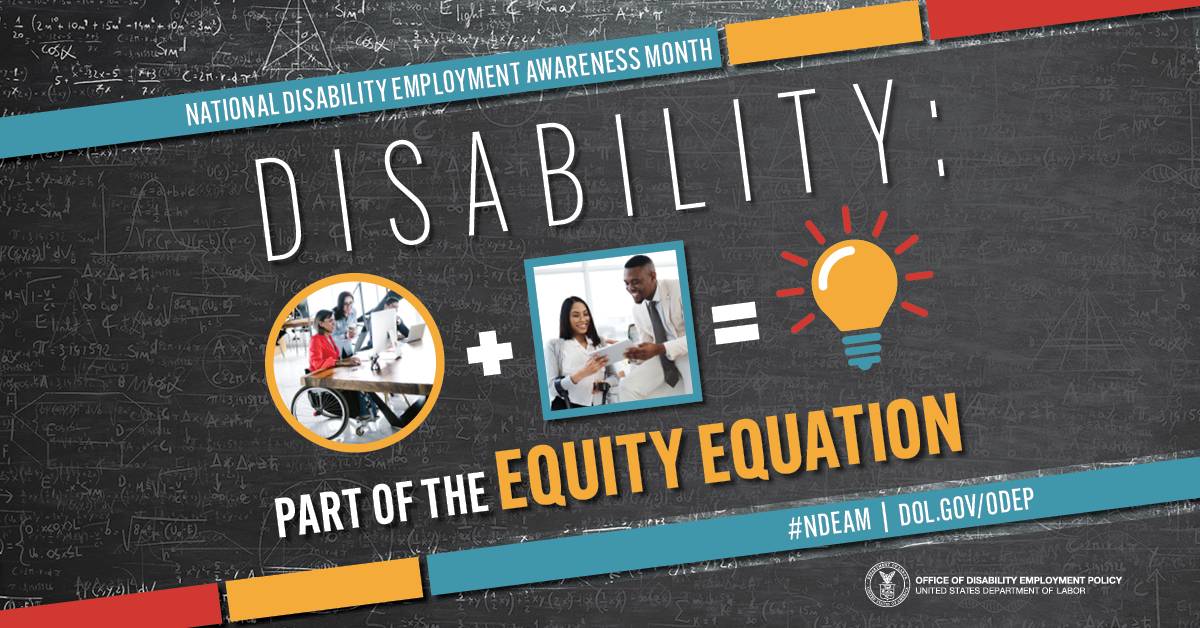This year’s National Disability Employment Awareness Month (NDEAM) theme, Disability: Part of the Equity Equation, led us to reflect on our own workplace and how Mathematica incorporates diverse voices from people with disabilities throughout our organization. We approached this from two different perspectives. Naomi is an employee with a disability who chose to work at Mathematica in part because it was consistent with her goal of working in an accessible and inclusive environment. Jody has been at Mathematica for more than 16 years and has conducted a range of research projects related to disability and employment. She seeks to be a strong ally of co-workers with disabilities.
Together, we learned in talking with colleagues throughout the organization that co-workers are best positioned to champion inclusion, building from the floor for accessibility set by formal processes for flexible work arrangements and providing accommodations. Mathematica has been ranked as a Best Place to Work for Disability Inclusion for the past three years based on the Disability:IN Disability Equality Index, and our Human Resources Department and management use evidence-based practices and continual learning to improve our practices to proactively support workers with disabilities. To be sure, corporate practices around incorporating disability into the equity equation are necessary. Without strong action from company leaders, the actions of co-workers alone would not support full inclusivity.
Yet for people with disabilities, corporate metrics around hiring, retention, and accommodation requests can’t fully capture the day-to-day work experience of being fully included in the workplace. Inclusion is more than just arrangements for accommodations; it must be embedded into all facets of work—on tasks, in meetings, and among teams. Ensuring that inclusion is rooted in a corporate mindset or value statement and not just part of a one-off initiative is a consistent theme in the recent movement for equity, so we were excited to see NDEAM state so explicitly that disability should be part of the equity equation. Without a sustained collective commitment to accessibility within a company, workers with disabilities bear the burden of having to continually explain and advocate for the tools they need to succeed at work. This can be tiring and isolating. As one colleague told us, “With a limited amount of spoons each day, I’d prefer to use what I have on contributing meaningfully to work rather than continually having to remind people of my accommodation needs to do that work.”
All co-workers are essential allies in making sure that co-workers with disabilities are fully included in the day-to-day workplace. There are many ways that we can all can build on formal human resources processes and support co-workers with disabilities:
- Be proactive in asking new team members about what they need to participate fully and successfully on the team. People use various adaptive technology and strategies, and you cannot assume you know the best way to support a co-worker based on their disability. Even the suggestions that follow are not universal—what works well for some may not be best for others. The way to make sure you are supporting an equitable work environment where everyone can do their best work is to ask.
- Embed inclusive practices proactively in all aspects of your work, just as you would all other aspects of project management. As one of our colleagues noted, “accessibility cannot be an afterthought.” Many disabilities are invisible, and some people may be hesitant to disclose disabling conditions. Learning the preferences of co-workers in advance and building inclusive practices like the ones highlighted here into all of your activities reduces the burden of having to ask for accommodations and enables co-workers with disabilities to be able to focus on their work.
- Be mindful of work schedules and avoid scheduling meetings or expecting rapid turnaround on tasks during colleagues’ off-hours. Workers with disabilities may use flexible and part-time schedules to manage their health conditions. When meetings are scheduled during their time off, they may feel obligated to attend or may feel guilty if they cannot. This can be especially challenging for co-workers with mental health conditions, who may rely on time off to manage their conditions and who may experience episodic and unpredictable times away from work. Do not put co-workers in the position of having to decline meetings at times when you know they would not otherwise be working.
- Use accessible technology for meetings and evaluate alternatives to be more inclusive. Though the world is increasingly connected thanks to technology, not every co-worker can engage in virtual meetings in the same way. Using inaccessible technologies during meetings—including things like virtual whiteboards or video clips without available captioning—can be exclusionary. Asking colleagues with disabilities to participate in the meeting in a way that is different from everyone else—like sending feedback by email instead of using the virtual whiteboard—is inequitable.
- Schedule meetings in advance when possible. Last-minute meeting scheduling can put the burden on some of your co-workers with disabilities to rush to get their accommodations in place—whether it means requesting slides in advance of the meeting or booking a sign language interpreter. In some cases, this may mean that your co-worker can’t participate at all. This can create additional stress for colleagues with disabilities requiring these accommodations. While it may not always be possible, building in time ahead of meetings enables everyone to come prepared and to fully participate.
- When planning social events at work—or even outside of work—prioritize accessibility needs. Co-workers with disabilities should be included in all aspects of the workplace, including social events. Accessibility doesn’t end when you walk out of the office. Make sure colleagues can fully participate in all events outside of work. When planning activities like meetings, conferences, or holiday parties off-site, look for locations that enable full participation by those with mobility impairments.
- Seek equity in leadership opportunities. Like all other colleagues, co-workers with disabilities are well-positioned to serve in leadership roles. Do not overlook the importance of incorporating diverse voices in leadership positions—in addition to benefitting the work, this will send a strong signal to others in the organization that people with disabilities are valued contributors.
- Understand that you may not always get things right. Approach inclusivity with humility, and don’t be afraid to learn from your mistakes. Open and honest communication with your colleagues with disabilities is critical for growth, learning, and proactive problem-solving.
Based on our conversations, we feel confident that our Mathematica colleagues are fully committed to equity and inclusion, but these lessons are applicable for any like-minded organization. As one of our disabled co-workers told us, “Disabilities come in all shapes and sizes, including invisible disabilities like mine. You never know what a person is going through on any given day, so it’s always worth meeting people where they are with kindness and empathy. So many people at Mathematica intentionally try to do this, and I will be forever grateful to work with such amazing colleagues.” Even with best intentions, some may need practical tips to support co-workers with disabilities. We hope we have provided some action-oriented suggestions for embedding inclusivity into daily work life.




